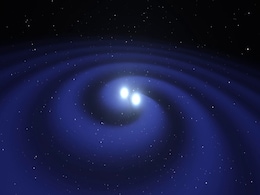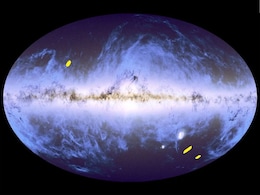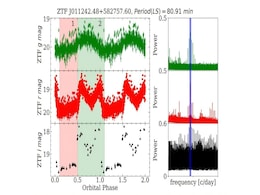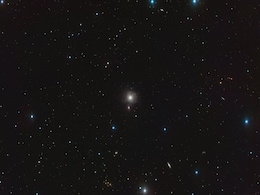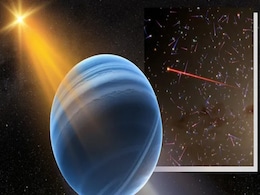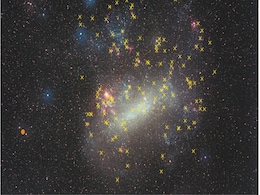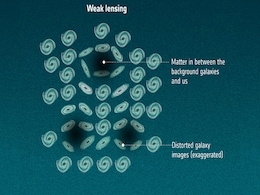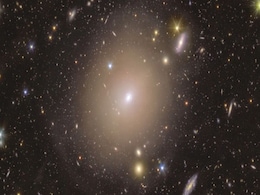Gravitating
- All
- News
- Videos
-

Magnetic Fields Could Significantly Influence Oscillations in Merging Neutron Stars, Study Finds
- Saturday April 26, 2025
- Written by Gadgets 360 Staff
Magnetic fields may play a bigger role in neutron star mergers than previously thought. A new study using advanced simulations shows that these fields can shift or suppress oscillation frequencies, altering gravitational wave signatures. This discovery could change how astronomers decode post-merger signals and refine models of neutron star interio...
-
 www.gadgets360.com
www.gadgets360.com
-

James Webb Space Telescope Reveals a Stunning Einstein Ring in Hydrus
- Wednesday April 2, 2025
- NDTV
A striking new image from the James Webb Space Telescope reveals an Einstein ring in the Hydrus constellation. The phenomenon occurs when a massive foreground galaxy bends light from a hidden background galaxy, forming a near-perfect ring. This effect, predicted by Einstein’s theory of general relativity, helps astronomers study galaxies from the...
-
 www.gadgets360.com
www.gadgets360.com
-

ESA’s Euclid Telescope Releases First Data, Mapping 26 Million Galaxies
- Wednesday March 26, 2025
- Written by Gadgets 360 Staff
ESA’s Euclid telescope has released its first dataset, mapping 26 million galaxies within a week. The observations include deep-field images, a survey of 380,000 galaxies, and 500 new gravitational lens candidates. Scientists will continue tracking cosmic evolution over six years. The dataset, currently 35 terabytes, is expected to grow to 2 peta...
-
 www.gadgets360.com
www.gadgets360.com
-

New Dark Matter Hypothesis Suggests Ionisation Clue in Milky Way’s Core
- Wednesday March 12, 2025
- Written by Gadgets 360 Staff
Researchers propose that an overlooked dark matter candidate may explain unusual ionisation levels in the Milky Way’s Central Molecular Zone (CMZ). This theory suggests that lightweight, self-annihilating dark matter particles could be producing electrons and positrons, influencing cosmic chemistry. The findings challenge conventional views, offe...
-
 www.gadgets360.com
www.gadgets360.com
-

New Polar Cataclysmic Variable Identified by Astronomers: What You Need to Know
- Friday March 7, 2025
- Written by Gadgets 360 Staff
Astronomers have detected ZTF J0112+5827, a newly identified polar cataclysmic variable. This binary system, composed of a white dwarf and a low-mass donor star, features an 80.9-minute orbital period and a strong magnetic field of 38.7 MG. It lacks an accretion disk, with emissions mainly from its accretion stream and magnetic field lines. The sys...
-
 www.gadgets360.com
www.gadgets360.com
-

Black Hole Singularities May Not Exist, Say Scientists
- Friday March 7, 2025
- Written by Gadgets 360 Staff
A new study questions the existence of black hole singularities, suggesting refinements to Einstein’s equations using quantum gravity concepts. Researchers argue that infinite density points may not be real, replacing them with highly curved but finite regions of space-time. While direct observation remains difficult, gravitational waves and earl...
-
 www.gadgets360.com
www.gadgets360.com
-

X-ray Signal from Helix Nebula Suggests Planet Was Destroyed by White Dwarf
- Thursday March 6, 2025
- Written by Gadgets 360 Staff
Astronomers have traced decades-old X-ray emissions from the Helix Nebula to a white dwarf possibly consuming planetary debris. Reports suggest a Jupiter-like planet may have been torn apart by the star’s intense gravitational forces. Data from NASA’s Chandra X-ray Observatory and ESA’s XMM-Newton indicate that remnants of the destroyed plane...
-
 www.gadgets360.com
www.gadgets360.com
-

Unexpected Rotational Motion Detected in Ultra-Diffuse Galaxies of Hydra Cluster
- Wednesday March 5, 2025
- Written by Gadgets 360 Staff
Astronomers studying ultra-diffuse galaxies (UDGs) in the Hydra cluster have observed unexpected rotational movement in nearly half of the 30 galaxies examined. Spectroscopic data from the LEWIS programme, using the MUSE instrument on the Very Large Telescope, suggests that gravitational interactions with larger galaxies may influence their formati...
-
 www.gadgets360.com
www.gadgets360.com
-

New Study Reveals How Pulsars Help Measure Dark Matter in the Milky Way
- Tuesday March 4, 2025
- Written by Gadgets 360 Staff
A breakthrough study has used pulsar acceleration data to measure dark matter density in the Milky Way. Previously, binary pulsars were the primary source of data, but now solitary pulsars have been included, doubling the dataset. The research also provides evidence of the Milky Way’s "wobble" due to interactions with dwarf galaxies. By mapping t...
-
 www.gadgets360.com
www.gadgets360.com
-

Astronomers Spot Galaxy NGC 3640 With a Past of Consuming Smaller Galaxies
- Tuesday February 25, 2025
- Written by Gadgets 360 Staff
Recent observations of NGC 3640 reveal a history of merging with smaller galaxies. Located 88 million light-years away, the elliptical galaxy is suspected to be on a collision course with NGC 3641. The Very Large Telescope captured structural distortions, hinting at previous mergers. Researchers have identified ancient stars acting as fossil marker...
-
 www.gadgets360.com
www.gadgets360.com
-

A Neptune-Like Exoplanet Is Racing Through Space at Record Speed
- Monday February 17, 2025
- Written by Gadgets 360 Staff
Scientists have detected an exoplanet racing through space at 1.2 million mph, making it the fastest known planet. The Neptune-sized world orbits a hypervelocity star, first hinted at in 2011 via gravitational microlensing. Astronomers, using Keck Observatory and Gaia data, have confirmed the system’s extreme speed, suggesting it may even leave t...
-
 www.gadgets360.com
www.gadgets360.com
-

Physicists Discover Singularities-Free Black Holes Using Pure Gravity
- Friday February 14, 2025
- Written by Gadgets 360 Staff
Physicists at ICCUB have mathematically proven that black holes can form without singularities, eliminating the need for exotic matter. The study, published in Physics Letters B, demonstrates that higher-order gravitational corrections alone can generate regular black holes. This breakthrough challenges previous models and provides new insights int...
-
 www.gadgets360.com
www.gadgets360.com
-

Scientists Discover Two New Supernova Remnants in a Surprising Location
- Thursday February 13, 2025
- Written by Gadgets 360 Staff
Two previously unknown supernova remnants, J0624-6948 and J0614-7251, have been detected in the outskirts of the Large Magellanic Cloud. Their unexpected location suggests a higher-than-expected concentration of ionised gas, raising new questions about galactic evolution. Scientists propose that gravitational interactions between the Milky Way and ...
-
 www.gadgets360.com
www.gadgets360.com
-

Weak Gravitational Lensing Examines Universe’s Structure: What You Need to Know
- Thursday February 13, 2025
- Written by Gadgets 360 Staff
The universe's large-scale uniformity is under scrutiny through weak gravitational lensing. Researchers are analysing data from the Euclid Space Telescope to detect potential anisotropies in cosmic expansion. If confirmed, these findings could challenge the fundamental Cosmological Principle, which assumes the universe has no preferred direction. T...
-
 www.gadgets360.com
www.gadgets360.com
-

Euclid Space Telescope Discovers Rare Einstein Ring, Revealing Dark Matter Secrets
- Wednesday February 12, 2025
- Written by Gadgets 360 Staff
The Euclid space telescope has detected a rare Einstein ring around galaxy NGC 6505, located approximately 590 million light-years from Earth. This phenomenon, resulting from gravitational lensing, allows scientists to study the distribution of dark matter within the lensing galaxy. The discovery aligns with Euclid's mission to map cosmic structure...
-
 www.gadgets360.com
www.gadgets360.com
-

Magnetic Fields Could Significantly Influence Oscillations in Merging Neutron Stars, Study Finds
- Saturday April 26, 2025
- Written by Gadgets 360 Staff
Magnetic fields may play a bigger role in neutron star mergers than previously thought. A new study using advanced simulations shows that these fields can shift or suppress oscillation frequencies, altering gravitational wave signatures. This discovery could change how astronomers decode post-merger signals and refine models of neutron star interio...
-
 www.gadgets360.com
www.gadgets360.com
-

James Webb Space Telescope Reveals a Stunning Einstein Ring in Hydrus
- Wednesday April 2, 2025
- NDTV
A striking new image from the James Webb Space Telescope reveals an Einstein ring in the Hydrus constellation. The phenomenon occurs when a massive foreground galaxy bends light from a hidden background galaxy, forming a near-perfect ring. This effect, predicted by Einstein’s theory of general relativity, helps astronomers study galaxies from the...
-
 www.gadgets360.com
www.gadgets360.com
-

ESA’s Euclid Telescope Releases First Data, Mapping 26 Million Galaxies
- Wednesday March 26, 2025
- Written by Gadgets 360 Staff
ESA’s Euclid telescope has released its first dataset, mapping 26 million galaxies within a week. The observations include deep-field images, a survey of 380,000 galaxies, and 500 new gravitational lens candidates. Scientists will continue tracking cosmic evolution over six years. The dataset, currently 35 terabytes, is expected to grow to 2 peta...
-
 www.gadgets360.com
www.gadgets360.com
-

New Dark Matter Hypothesis Suggests Ionisation Clue in Milky Way’s Core
- Wednesday March 12, 2025
- Written by Gadgets 360 Staff
Researchers propose that an overlooked dark matter candidate may explain unusual ionisation levels in the Milky Way’s Central Molecular Zone (CMZ). This theory suggests that lightweight, self-annihilating dark matter particles could be producing electrons and positrons, influencing cosmic chemistry. The findings challenge conventional views, offe...
-
 www.gadgets360.com
www.gadgets360.com
-

New Polar Cataclysmic Variable Identified by Astronomers: What You Need to Know
- Friday March 7, 2025
- Written by Gadgets 360 Staff
Astronomers have detected ZTF J0112+5827, a newly identified polar cataclysmic variable. This binary system, composed of a white dwarf and a low-mass donor star, features an 80.9-minute orbital period and a strong magnetic field of 38.7 MG. It lacks an accretion disk, with emissions mainly from its accretion stream and magnetic field lines. The sys...
-
 www.gadgets360.com
www.gadgets360.com
-

Black Hole Singularities May Not Exist, Say Scientists
- Friday March 7, 2025
- Written by Gadgets 360 Staff
A new study questions the existence of black hole singularities, suggesting refinements to Einstein’s equations using quantum gravity concepts. Researchers argue that infinite density points may not be real, replacing them with highly curved but finite regions of space-time. While direct observation remains difficult, gravitational waves and earl...
-
 www.gadgets360.com
www.gadgets360.com
-

X-ray Signal from Helix Nebula Suggests Planet Was Destroyed by White Dwarf
- Thursday March 6, 2025
- Written by Gadgets 360 Staff
Astronomers have traced decades-old X-ray emissions from the Helix Nebula to a white dwarf possibly consuming planetary debris. Reports suggest a Jupiter-like planet may have been torn apart by the star’s intense gravitational forces. Data from NASA’s Chandra X-ray Observatory and ESA’s XMM-Newton indicate that remnants of the destroyed plane...
-
 www.gadgets360.com
www.gadgets360.com
-

Unexpected Rotational Motion Detected in Ultra-Diffuse Galaxies of Hydra Cluster
- Wednesday March 5, 2025
- Written by Gadgets 360 Staff
Astronomers studying ultra-diffuse galaxies (UDGs) in the Hydra cluster have observed unexpected rotational movement in nearly half of the 30 galaxies examined. Spectroscopic data from the LEWIS programme, using the MUSE instrument on the Very Large Telescope, suggests that gravitational interactions with larger galaxies may influence their formati...
-
 www.gadgets360.com
www.gadgets360.com
-

New Study Reveals How Pulsars Help Measure Dark Matter in the Milky Way
- Tuesday March 4, 2025
- Written by Gadgets 360 Staff
A breakthrough study has used pulsar acceleration data to measure dark matter density in the Milky Way. Previously, binary pulsars were the primary source of data, but now solitary pulsars have been included, doubling the dataset. The research also provides evidence of the Milky Way’s "wobble" due to interactions with dwarf galaxies. By mapping t...
-
 www.gadgets360.com
www.gadgets360.com
-

Astronomers Spot Galaxy NGC 3640 With a Past of Consuming Smaller Galaxies
- Tuesday February 25, 2025
- Written by Gadgets 360 Staff
Recent observations of NGC 3640 reveal a history of merging with smaller galaxies. Located 88 million light-years away, the elliptical galaxy is suspected to be on a collision course with NGC 3641. The Very Large Telescope captured structural distortions, hinting at previous mergers. Researchers have identified ancient stars acting as fossil marker...
-
 www.gadgets360.com
www.gadgets360.com
-

A Neptune-Like Exoplanet Is Racing Through Space at Record Speed
- Monday February 17, 2025
- Written by Gadgets 360 Staff
Scientists have detected an exoplanet racing through space at 1.2 million mph, making it the fastest known planet. The Neptune-sized world orbits a hypervelocity star, first hinted at in 2011 via gravitational microlensing. Astronomers, using Keck Observatory and Gaia data, have confirmed the system’s extreme speed, suggesting it may even leave t...
-
 www.gadgets360.com
www.gadgets360.com
-

Physicists Discover Singularities-Free Black Holes Using Pure Gravity
- Friday February 14, 2025
- Written by Gadgets 360 Staff
Physicists at ICCUB have mathematically proven that black holes can form without singularities, eliminating the need for exotic matter. The study, published in Physics Letters B, demonstrates that higher-order gravitational corrections alone can generate regular black holes. This breakthrough challenges previous models and provides new insights int...
-
 www.gadgets360.com
www.gadgets360.com
-

Scientists Discover Two New Supernova Remnants in a Surprising Location
- Thursday February 13, 2025
- Written by Gadgets 360 Staff
Two previously unknown supernova remnants, J0624-6948 and J0614-7251, have been detected in the outskirts of the Large Magellanic Cloud. Their unexpected location suggests a higher-than-expected concentration of ionised gas, raising new questions about galactic evolution. Scientists propose that gravitational interactions between the Milky Way and ...
-
 www.gadgets360.com
www.gadgets360.com
-

Weak Gravitational Lensing Examines Universe’s Structure: What You Need to Know
- Thursday February 13, 2025
- Written by Gadgets 360 Staff
The universe's large-scale uniformity is under scrutiny through weak gravitational lensing. Researchers are analysing data from the Euclid Space Telescope to detect potential anisotropies in cosmic expansion. If confirmed, these findings could challenge the fundamental Cosmological Principle, which assumes the universe has no preferred direction. T...
-
 www.gadgets360.com
www.gadgets360.com
-

Euclid Space Telescope Discovers Rare Einstein Ring, Revealing Dark Matter Secrets
- Wednesday February 12, 2025
- Written by Gadgets 360 Staff
The Euclid space telescope has detected a rare Einstein ring around galaxy NGC 6505, located approximately 590 million light-years from Earth. This phenomenon, resulting from gravitational lensing, allows scientists to study the distribution of dark matter within the lensing galaxy. The discovery aligns with Euclid's mission to map cosmic structure...
-
 www.gadgets360.com
www.gadgets360.com

